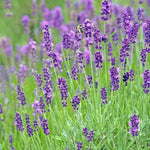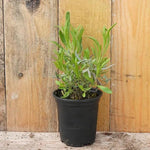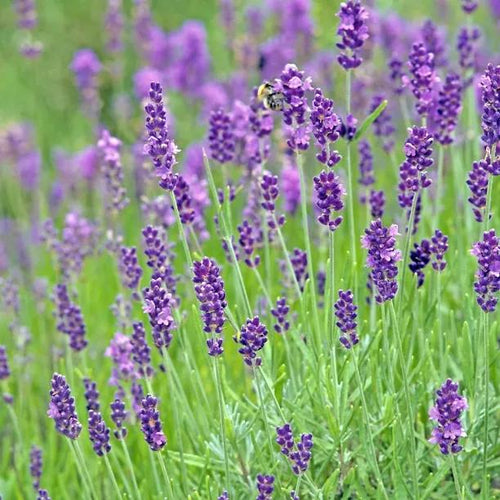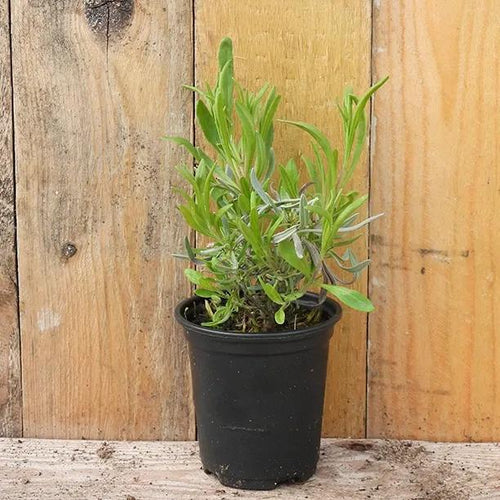Vera Dutch Lavender Plants
Vera Lavender is a vigorous sub-shrub with long, slender flower spikes covered with tiny violet-blue scented blooms. With its grey-green evergreen foliage, it provides colour and interest through the year making it ideal as a structural component in beds and borders, and as a fragrant hedge alongside a path.
Have a look at the rest of our lavender range here. Vera will make a hedge up to 1m tall. For something larger, browse our full range of hedging.
Delivery season: This is weather dependent. At present we expect to have plants ready from the end of April onwards, but if the weather is cold dates can slip into May. There is nothing to be gained from trying to plant lavender out before nighttime temperatures rise consistently as the shock simply sets it back, and it establishes more slowly and flowers less well than lavender planted when everything is warmer. The smallest lavenders, in P9 pots, are never shipped before May in any event. If you aren't happy with these potentially uncertain timings, please order elsewhere: we guarantee our plants and like to see them do well...
Choosing a size:
- For window boxes and other containers, start with the smallest plants, which come in P9 pots and are a year old. If you plant them outside, do it from the end of May when the soil is nice and warm. They're also the cheapest way to start a lavender hedge, you only have to wait a year or two longer for them to knit together.
- For quick borders, hedges and edges, or simply specimen shrubs that provide "instant" impact, larger plants in 2 litre pots are ideal. You get more root and more flower in the first year, and they don't look lost planted at one plant every 13" (33cm). By the end of the first summer, they'll have joined up.
Features
- Use: Plant at 60cm intervals for hedges and edges
- Height: 1.1 m
- Spread: 1.1 m
- Colour: deep violet/blue flowers
- Shape: long flower spikes
- Aspect: south facing
- Scent: strong, lavender
- Flowering: summer-early autumn
- Leaves: evergreen, grey-green narrow foliage
Growing Vera Lavender
She prefers a neutral to alkaline, poor to moderately fertile soil in a sheltered position, but it can tolerate acid conditions. Plant in full sun and well-drained soil, as lavender struggles with wet conditions in winter. Drought-tolerant and very hardy providing it's grown in favourable conditions.
Spacing a Vera Lavender hedge:
Best planted at 60cm apart for a really nice tight formal hedge, but it'll still look fine with a looser 90cm spacing.
Garden Design Ideas
Lavender is traditionally used for scented hedging alongside paths and walls, or to edge cottage garden borders. A versatile specimen shrub, it can be clipped to create evergreen structure in a formal garden or left to grow naturally in more informal designs.
In a drought-tolerant border, lavender combines well with echinacea, cosmos, lamb's ear and sedum. Vera is perfect for herb beds and provides wonderful cut flower stems. For a modern prairie border, try pairing with Mexican feather grass or tufted hair grass to create a loose, ethereal style.
History & Trivia
The name lavender is thought to derive from the Latin lavare 'to wash' because the Greeks and Romans added lavender flowers to their baths to sweeten the water. Intermedia refers to the cross between English and Portuguese lavender that created this taller form, which is commonly called Lavandin.
This hybrid cultivar is called Lavandula x intermedia 'Vera'.
Lavandula vera was an alternative species name for the "true" lavender, Lavandula angustifolia, and there is a Lavandula angustifolia 'Vera' cultivar as well, although the RHS lists them ambiguously together.
Lavender has been used for centuries in herbalism to dress wounds, aid sleep and alleviate anxiety. The sweet fragrance is still added to soaps, perfumes and essential oils, and the petals can even be used sparingly in cakes and biscuits.








 Secure, One-Tap Checkout
Secure, One-Tap Checkout
 Hand Picked, Delivered to Your Door!
Hand Picked, Delivered to Your Door! 1 Year Bareroot Guarantee
1 Year Bareroot Guarantee


